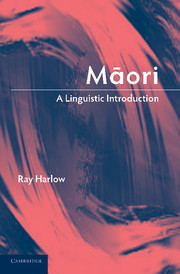Book contents
- Frontmatter
- Contents
- List of figures
- List of maps
- List of tables
- Acknowledgements
- List of abbreviations
- Introduction
- 1 Māori literature and literature on Māori
- 2 A brief history of Māori
- 3 Regional variation in Māori
- 4 The phonology of Māori
- 5 The morphology of Māori
- 6 The syntax of Māori
- 7 The sociolinguistic situation of Māori
- References
- Index
3 - Regional variation in Māori
Published online by Cambridge University Press: 28 January 2010
- Frontmatter
- Contents
- List of figures
- List of maps
- List of tables
- Acknowledgements
- List of abbreviations
- Introduction
- 1 Māori literature and literature on Māori
- 2 A brief history of Māori
- 3 Regional variation in Māori
- 4 The phonology of Māori
- 5 The morphology of Māori
- 6 The syntax of Māori
- 7 The sociolinguistic situation of Māori
- References
- Index
Summary
The Eastern Polynesian speech form which was to become the Māori language was brought to New Zealand as long as 800–1,000 years ago, and so far as we can tell spread rapidly over the whole of both major islands. Even assuming for the moment that this arrival was originally of a single group of people bringing a completely homogeneous speech form with them, it is not surprising that over time differences began to appear in this language in different areas. That is, Māori is not a single speech form, but has dialects. As will be seen, the differences lie predominantly in the lexicon and in some aspects of phonology, and are never such that mutual intellegibility is impaired.
That the language showed such variation has been noticed and commented on ever since there have been written records. Joseph Banks, for instance, included in his journal of the first voyage of the Endeavour (1769–70) lists of words labelled ‘northern’ (forty-two items) and ‘southern’ (twenty-six items) along with Tahitian equivalents. In fact, most of the items in the two Māori lists are clearly the same, but it is significant that even after such short contact with the language Banks was aware that there were regional differences he felt needed recognising.
Since that time, missionaries and writers of grammars and dictionaries, among other commentators, have all referred to the existence of regional variation, and in many cases given some few examples.
- Type
- Chapter
- Information
- MaoriA Linguistic Introduction, pp. 41 - 61Publisher: Cambridge University PressPrint publication year: 2007



